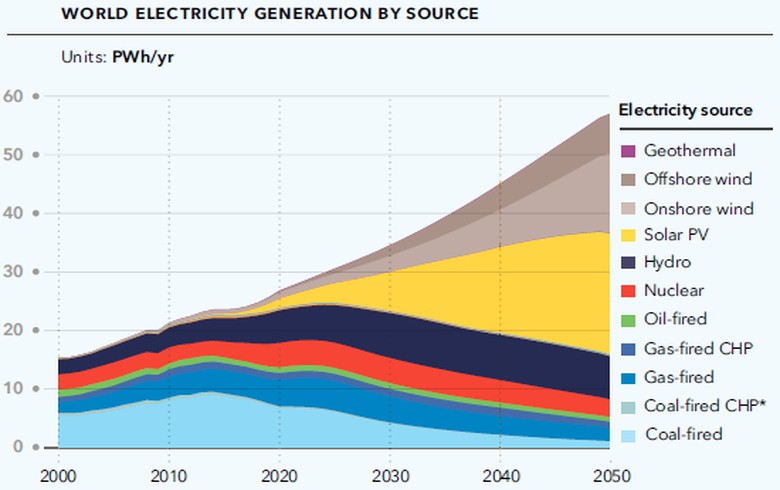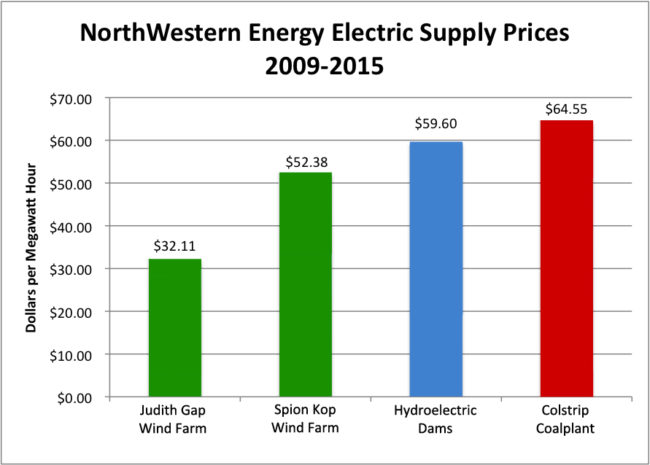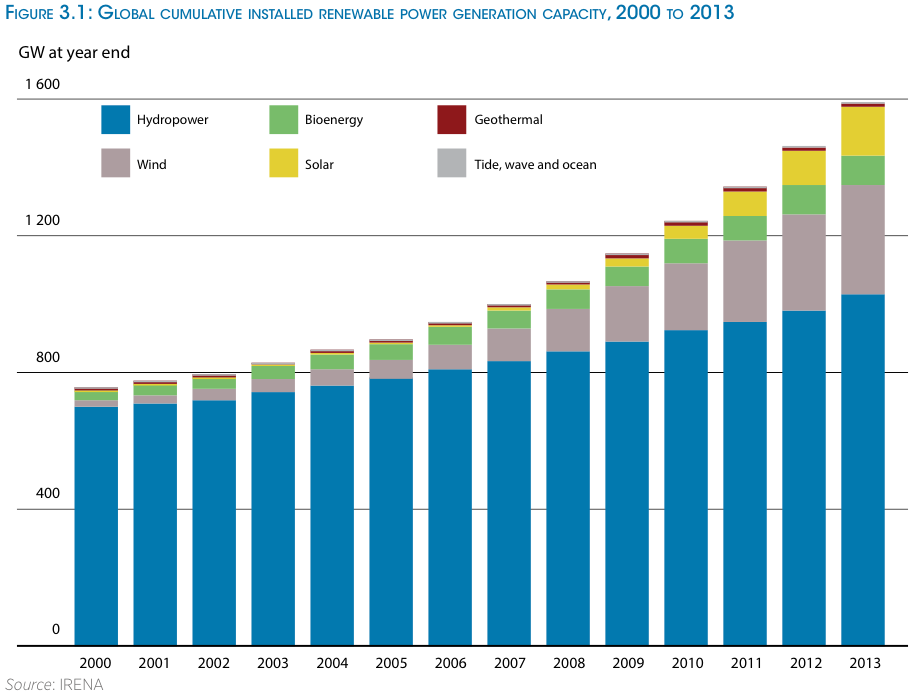These natural resources are formed from the remains of plants and animals that. IRENA says all renewable energy technologies should be competitive on price with fossil fuels by 2020 as further price falls are expected for these and other green energy options.

Renewables Produce 85 Of Global Power Nearly 50 Of Energy In 2050
In 2014 the US Energy Information Administration recommended that levelized costs of non-dispatchable sources such as wind or solar be compared to the levelized avoided cost of energy LACE rather than to the LCOE of dispatchable sources such as fossil fuels or geothermal.
. Burning these fossil fuels for electricity and heat is the largest single source of global greenhouse gases causing 30 of global emissions. Has come from coal oil and natural gas. Even those 50-64 emphasized renewable over fossil fuels by 59 to 32 and among those 65 and older renewables were still favored by 50 to 38.
Which energy source is NOT nondepletable. In a press release the organization reported that in many parts of the world it is now even cheaper to generate electricity from renewable sources. Clean energy is the low-cost option in a lot of these countries said Zindler in an interview.
Abu Dhabi United Arab Emirates June 22 2021 The share of renewable energy that achieved lower costs than the most competitive fossil fuel option doubled in 2020 a new report by the International Renewable Energy Agency. February 2 2015. And although solar and wind power are the main drivers of a shift to.
3 The chart here shows how the electricity prices from the long-standing. The cost of developing a CSP plant ranges from around 010kWh to 027kWh with an average price of around 018kWh. Renewable energy is energy produced from sources like the sun and wind that are naturally replenished and do not run out.
In 2021 the rollout of renewables increased by 6 despite cost increases and supply chain issues linked to the pandemic. Stems latest earnings were slightly below expectations. Biomass for power hydropower geothermal and onshore wind can all now provide electricity competitively compared to fossil fuel-fired power generation.
Coal is by far the biggest source supplying 37 of electricity. A wind b biomass c tidal d solar e hydroelectric. Revenue was 1274M an increase of 251 over 2020.
Although coal use has declined in recent years natural gas use has soared while oils share of the nations. Citing developments over the five-year period prior to that point the Times reported that -- with the help of subsidies -- renewable energy had become cost-competitive with conventional fossil. A tidal b geothermal c wind d solar photovoltaic.
High fossil fuel costs are intersecting with lower renewable prices especially relevant considering many Climatescope nations rely on volatile fossil fuel imports. Renewable energy is now a compelling alternative as it costs less than fossil fuels says Michael Milken Published Thu Sep 19 2019 321 AM EDT Updated Thu Sep 19 2019 343 AM EDT Huileng Tan. As far back as we have data most of the energy used in the US.
Renewable power is increasingly cheaper than any new electricity capacity based on fossil fuels according to a report recently released by the International Renewable Energy. The report acknowledges that costs vary by. Record-low auction prices for solar PV in Abu Dhabi and Dubai UAE Chile Ethiopia Mexico Peru and Saudi.
The lower estimate results in a cost per household of. Globally renewable energy capacity increased 6 to almost 295 GW in 2021. The surging cost of steel is set to boost wind turbine prices by as much as 17 this year.
Which aspects of renewable energy electricity generation require updating the electricity transmission grid. IRENA estimates that offshore wind and concentrating solar power should cost in a range of 006-010 per KwH by 2020-22. The cost of generating power from onshore wind has fallen by around 23 since 2010 while the cost of solar photovoltaic PV electricity has fallen by 73 in that time.
Powered by renewable energy instead of fossil-based electricity these systems could allow industries to move beyond fossil carbon According to Schaidle and his NREL colleague Gary Grim that alternative method of making fuels and chemicals could be a critical tool in decarbonizing an economic sector that often leaves deep carbon. Much of the worlds energy is produced by burning fossil fuels such as oil coal and gas. Renewable energy is also increasingly becoming more cost-competitive with existing fossil fuel power sourcing and a decrease on foreign oil spending could help offset any differences in price.
A new report by IRENA International Renewable Energy Agency this month asserts renewable energy generation is now cost-competitive with fossil fuels despite falling oil prices. The worlds electricity supply is dominated by fossil fuels. The report which is ninth in a series of studies on electricity generating costs to inform policymakers and other decisionmakers is based on expected 2025 plant-level costs reported by 243 plants in 24 countries ranging in energy source from coal and natural gas to solar and wind to nuclear energy.
The ability of renewable energy to compete effectively against the older. LACE is the avoided costs from other sources divided by the annual. In 2018 those fossil fuels fed about 80 of the nations energy demand down slightly from 84 a decade earlier.
Higher commodity and freight prices are driving up solar PV and wind turbine costs but renewables are still more cost-competitive than fossil fuels. The technologies are cost-competitive right now not in the future but. Renewable energy can be used for electricity generation space and water heating and cooling and transportation.
There are several studies that indicate it would cost the United States trillions of dollars to transition to an electric system that is 100-percent renewable. Countries urged to power past coal as new report confirms renewables would bring cost savings of USD 156 billion to emerging economies. Gas is second and supplies 24.
Costs range from 45 trillion by 2030 or even 2040 to 57 trillion in 2030about a quarter of the US. What are fossil fuels. The high growth comes at a cost.
Solar PV prices based on competitive procurement could average USD 0039kWh for projects commissioned in 2021 down 42 compared to 2019 and more than one-fifth less than the cheapest fossil-fuel competitor namely coal-fired plants. Among young people 75 favored alternative energy compared to 19 interested in developing new sources of fossil fuels. Among those 30-49 years old the numbers were 72 renewable compared to 24 fossil.
Which renewable energy source has become cost-competitive with fossil fuels. Contact The Expert. Non-renewable energy in contrast comes from finite sources that could get used up such as fossil fuels like.
Still the overall trend for renewable power prices. Gross margins were only 1 and the adjusted EBITDA.

Cost Of Wind Vs Fossil Fuels Meic

6 Charts That Show Renewable Energy Is Getting Cheaper Grist

Plunging Prices Mean Building New Renewable Energy Is Cheaper Than Running Existing Coal
0 Comments